- Concerns
- Treatments
FACE TREATMENT
BODY TREATMENT
- Products
- About-us
- Media
- Blog
- Book Appointment

1. Sun Exposure
2. Hormonal Changes
3. Post-Inflammatory Hyperpigmentation (PIH)
4. Genetics
5. Medications and Chemicals
Treatments in Aesthetic Medicine
1. Topical Agents
Hydroquinone: A widely used depigmenting agent that inhibits tyrosinase, an enzyme crucial for melanin production. It is effective for treating melasma and other hyperpigmentation disorders.
Retinoids: Promote cell turnover and reduce melanin production. Retinoids like tretinoin are often used in combination with other treatments.
Vitamin C: An antioxidant that helps lighten pigmentation by inhibiting melanin synthesis and protecting skin cells from UV damage.
Kojic Acid and Azelaic Acid: Natural skin-lightening agents that reduce melanin production.
2. Chemical Peels:
Glycolic Acid: An alpha-hydroxy acid (AHA) that exfoliates the skin and promotes cell turnover, reducing the appearance of pigmentation.
Salicylic Acid: A beta-hydroxy acid (BHA) effective for treating acne-related hyperpigmentation.
Trichloroacetic Acid (TCA): Used in medium to deep peels for more severe pigmentation issues.
3. Laser Treatments:
Q-Switched Nd:YAG Laser: Targets melanin and breaks down pigmented cells, effectively treating various pigmentation disorders.
Fractional Lasers (e.g., Fraxel): Promote collagen production and skin resurfacing, improving overall skin tone and texture.
4. Microdermabrasion
5. Intense Pulsed Light (IPL):
6. Microneedling
7. Cryotherapy
8. Platelet-Rich Plasma (PRP) Therapy
1. Sun Protection:
2. Antioxidant-Rich Diet
3. Avoiding Triggers
Identifying and avoiding factors that exacerbate pigmentation, such as certain medications or cosmetics, can help manage the condition.
Conclusion
Pigmentation disorders can significantly impact an individual’s appearance and self-esteem. Advances in aesthetic medicine provide a variety of effective treatments tailored to different types of pigmentation issues. Combining preventive measures with appropriate medical treatments can help achieve optimal results and maintain healthy, even-toned skin. Consulting with a dermatologist or aesthetic specialist is essential for developing a personalized treatment plan.
Book an appointment